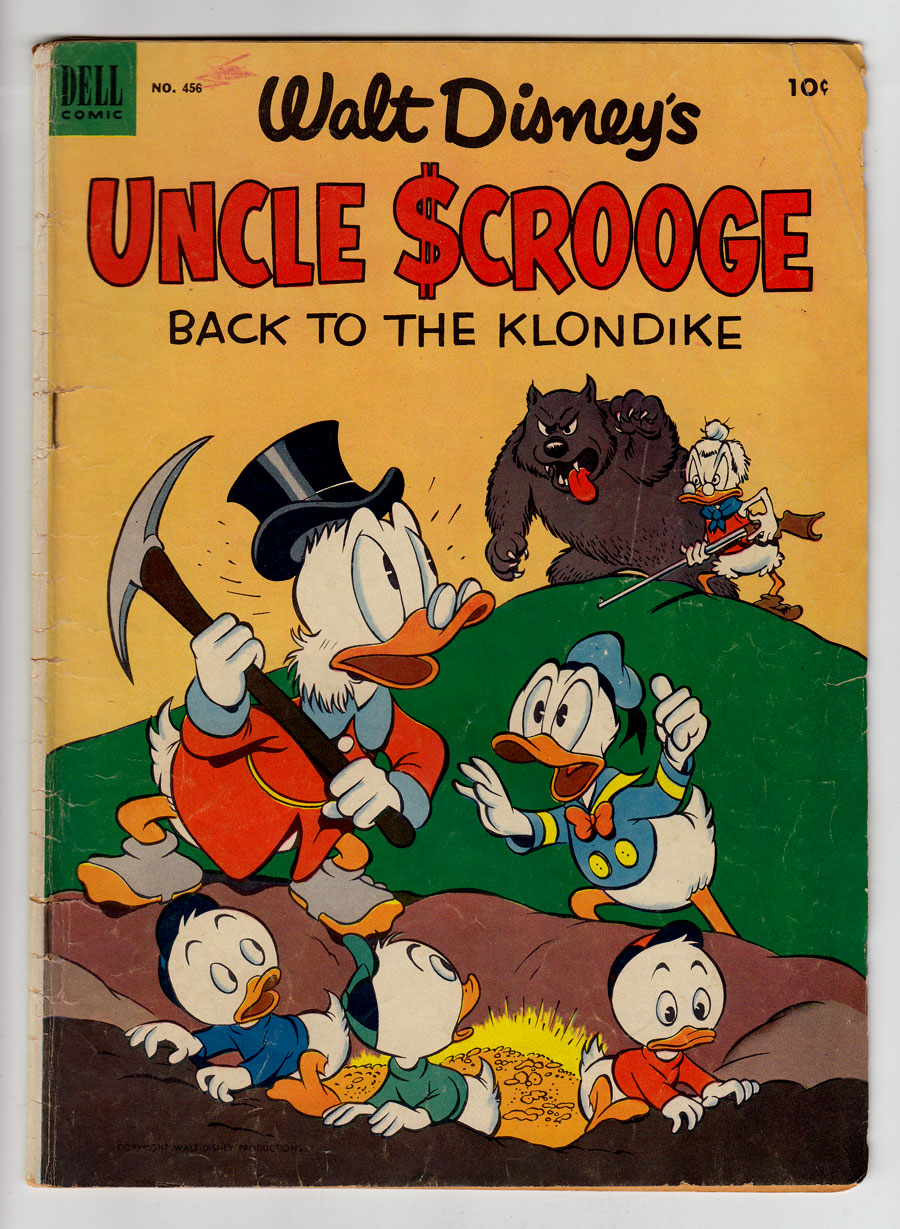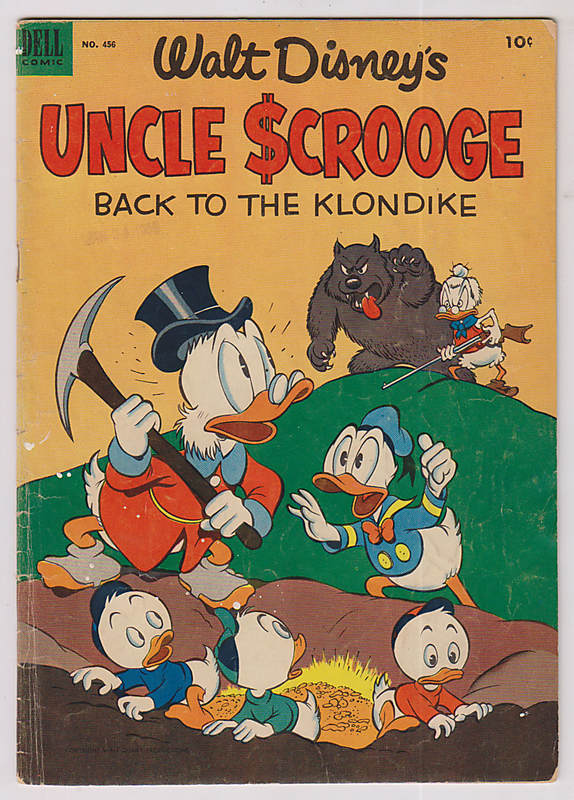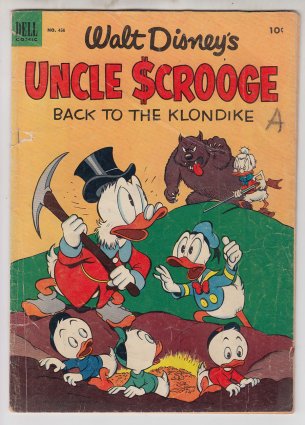UNCLE SCROOGE (1952-84) #2
G+: 2.5

(Stock Image)

YES
Accepting Offers
--
Offers
PUBLISHER: Dell
COMMENTS: F.C. #456; Back to the Klondike by Barks; COMIC BOOK IMPACT rating of 6 (CBI)
Read Description ▼
DESCRIPTION
F.C. #456; Back to the Klondike by Barks; COMIC BOOK IMPACT rating of 6 (CBI)Four Color #456 features the Barks' tale 'Back to the Klondike.' Scrooge McDuck returns to the Klondike where he has made his fortune, bringing Donald and the three nephews along, to find the gold he has left behind. The story presents the first appearance of Glittering Goldie and the begins the love/hate relationship that haunts Scrooge throughout his life.
We also see Scrooge making a conscious effort to deny his own feelings and emotions because he doesn't want to appear vulnerable. This has become an essential part of the character's way of thinking and acting in subsequent stories.
Artist Information
Carl Barks "The Duck Man" was an American cartoonist, comic book artist and painter who's famous for his freewheeling, high adventure stories at Disney focusing mostly on Donald Duck, his nephews, and their curmudgeonly Uncle Scrooge McDuck. Barks, who's career began in the early 1940s in Disney animation before transitioning over to the comic books where he had more freedom, in addition to introducing Uncle Scrooge, created many of the other supporting characters that have become beloved by fans in the ensuing decades, he was known only as "the good duck artist" for most of his career as his identity was largely unknown until the 1960s. Once his identity was revealed, and after his retirement from full time comic book making, Barks began a second career making oil paintings featuring recreations and reinterpretations of some of his classic duck imagery that have become coveted treasures. Barks' work from the 1940s is credited as inspiring a young Osamu Tezuka to give up his medical studies and devote his time in becoming a cartoonist, leading him to create Astro Boy and become the grandfather of Manga, the most popular form of comics in the world.
We also see Scrooge making a conscious effort to deny his own feelings and emotions because he doesn't want to appear vulnerable. This has become an essential part of the character's way of thinking and acting in subsequent stories.
Artist Information
Carl Barks "The Duck Man" was an American cartoonist, comic book artist and painter who's famous for his freewheeling, high adventure stories at Disney focusing mostly on Donald Duck, his nephews, and their curmudgeonly Uncle Scrooge McDuck. Barks, who's career began in the early 1940s in Disney animation before transitioning over to the comic books where he had more freedom, in addition to introducing Uncle Scrooge, created many of the other supporting characters that have become beloved by fans in the ensuing decades, he was known only as "the good duck artist" for most of his career as his identity was largely unknown until the 1960s. Once his identity was revealed, and after his retirement from full time comic book making, Barks began a second career making oil paintings featuring recreations and reinterpretations of some of his classic duck imagery that have become coveted treasures. Barks' work from the 1940s is credited as inspiring a young Osamu Tezuka to give up his medical studies and devote his time in becoming a cartoonist, leading him to create Astro Boy and become the grandfather of Manga, the most popular form of comics in the world.


UNCLE SCROOGE (1952-84) #2
Dell FN-: 5.5
F.C. #456; Back to the Klondike by Barks; COMIC BOOK IMPACT rating of 6 (CBI)
F.C. #456; Back to the Klondike by Barks; COMIC BOOK IMPACT rating of 6 (CBI)


UNCLE SCROOGE (1952-84) #2
Dell VG: 4.0
F.C. #456; Back to the Klondike by Barks; COMIC BOOK IMPACT rating of 6 (CBI)
F.C. #456; Back to the Klondike by Barks; COMIC BOOK IMPACT rating of 6 (CBI)


UNCLE SCROOGE (1952-84) #2
Dell VG-: 3.5
F.C. #456; Back to the Klondike by Barks; COMIC BOOK IMPACT rating of 6 (CBI)
F.C. #456; Back to the Klondike by Barks; COMIC BOOK IMPACT rating of 6 (CBI)


UNCLE SCROOGE (1952-84) #2
Dell G/VG: 3.0
glossy! ow/white pages
F.C. #456; Back to the Klondike by Barks; COMIC BOOK IMPACT rating of 6 (CBI)
F.C. #456; Back to the Klondike by Barks; COMIC BOOK IMPACT rating of 6 (CBI)
glossy! ow/white pages
F.C. #456; Back to the Klondike by Barks; COMIC BOOK IMPACT rating of 6 (CBI)
F.C. #456; Back to the Klondike by Barks; COMIC BOOK IMPACT rating of 6 (CBI)


UNCLE SCROOGE (1952-84) #2
Dell G+: 2.5
F.C. #456; Back to the Klondike by Barks; COMIC BOOK IMPACT rating of 6 (CBI)
F.C. #456; Back to the Klondike by Barks; COMIC BOOK IMPACT rating of 6 (CBI)



